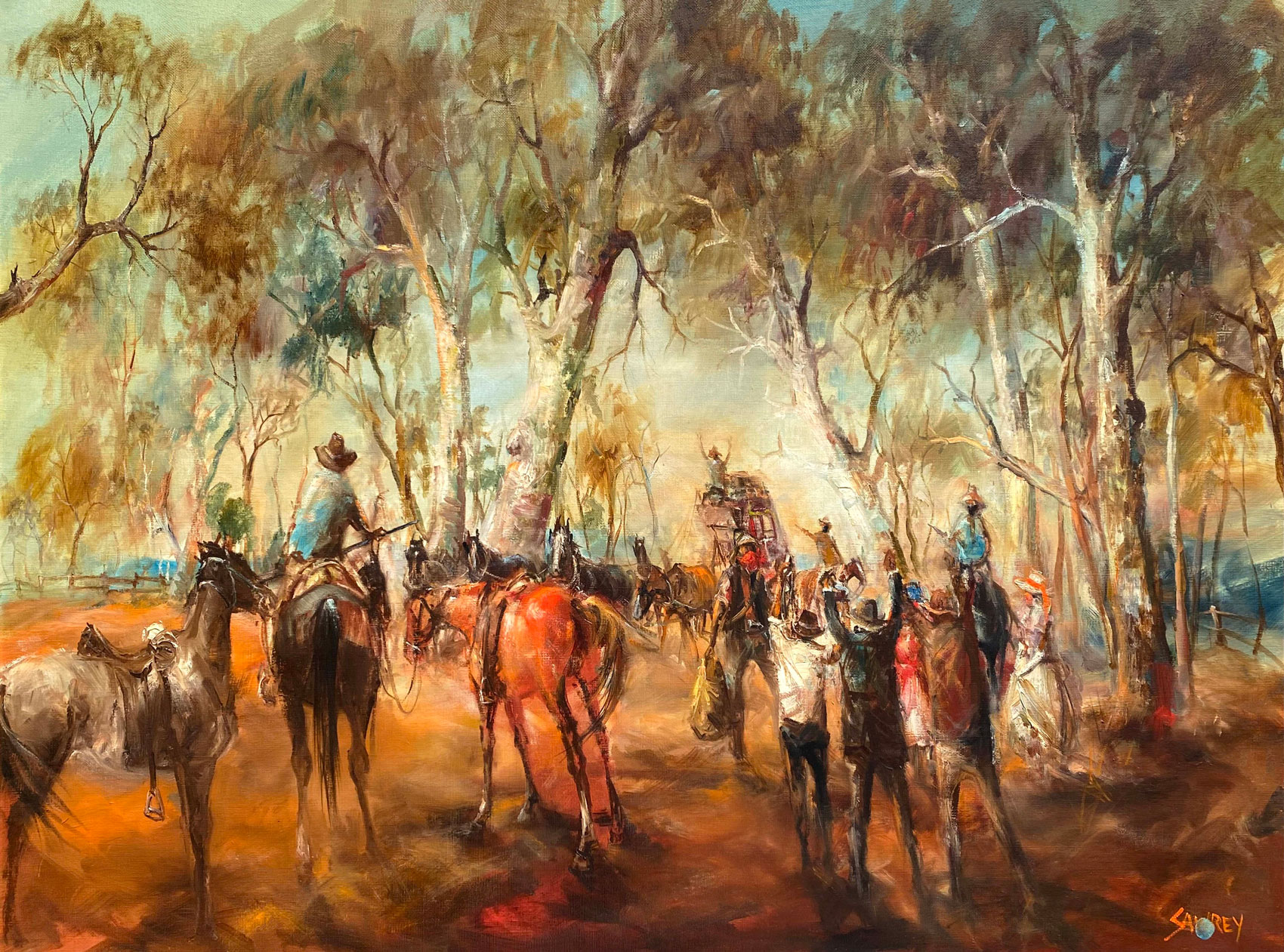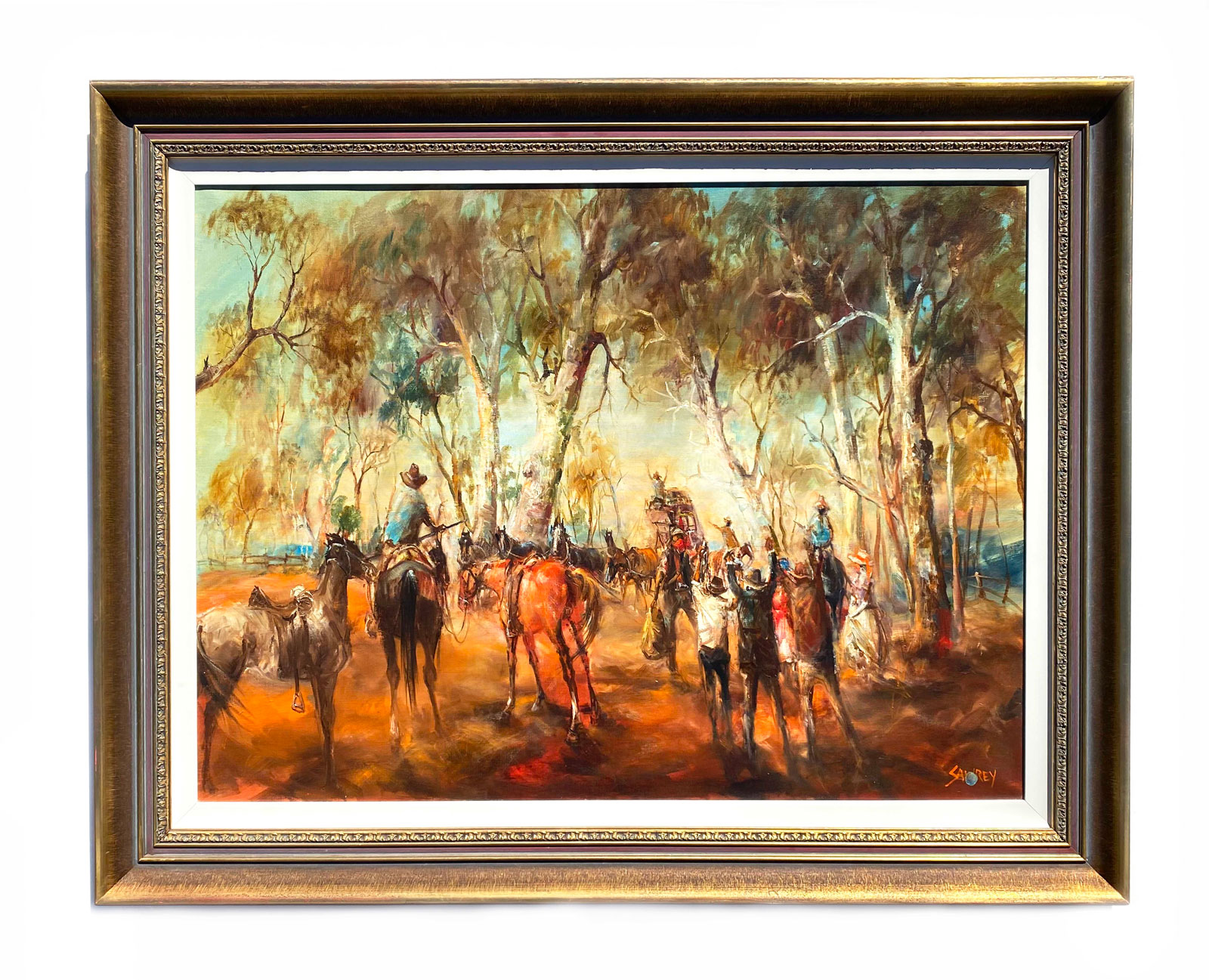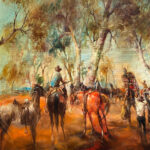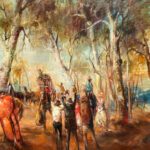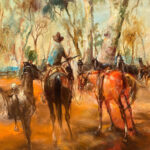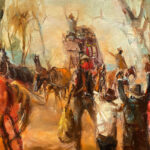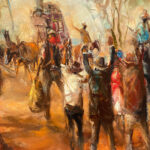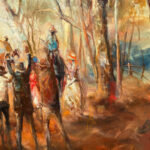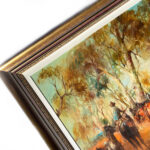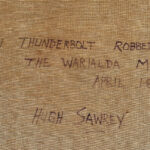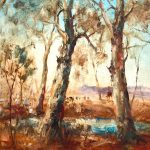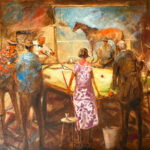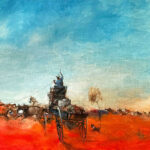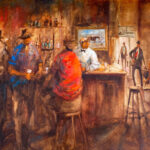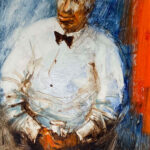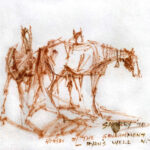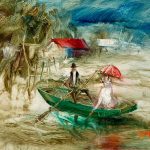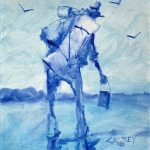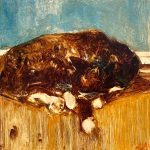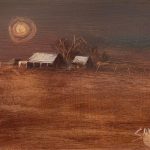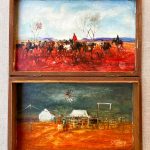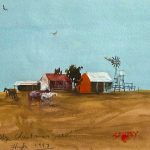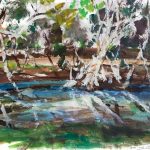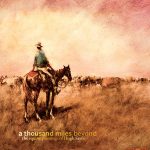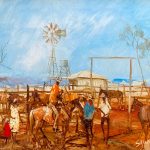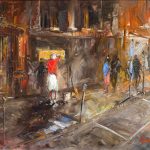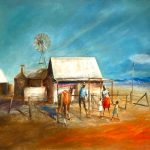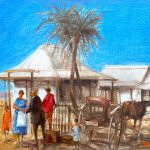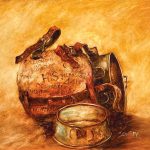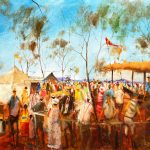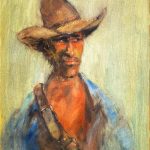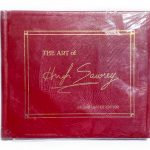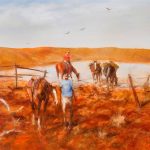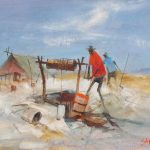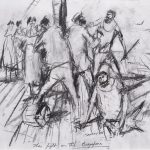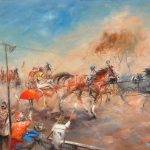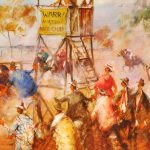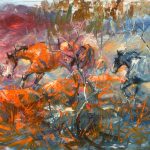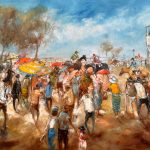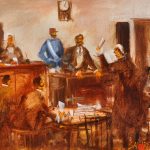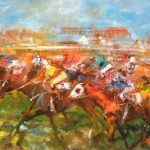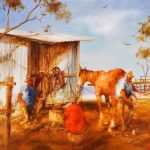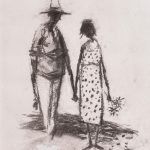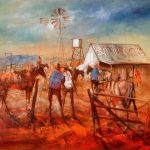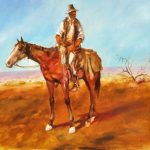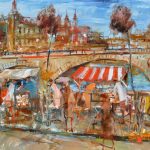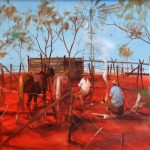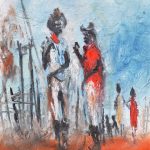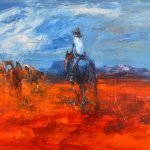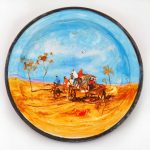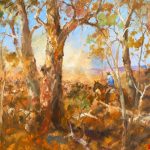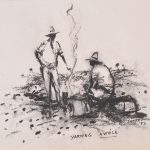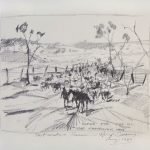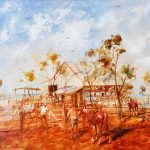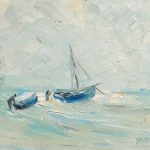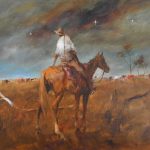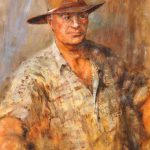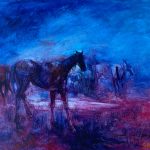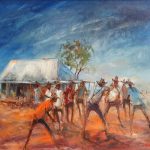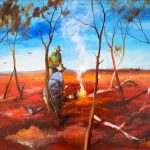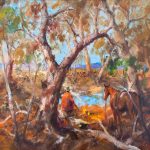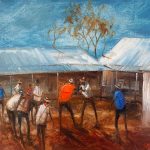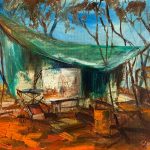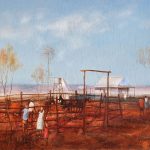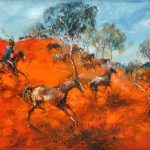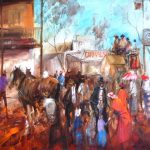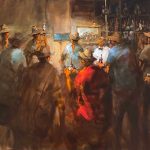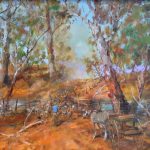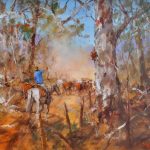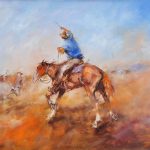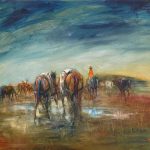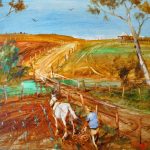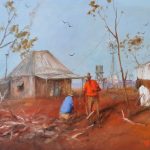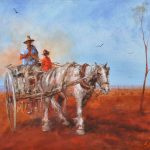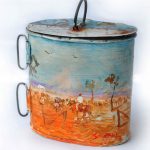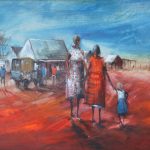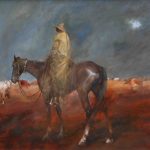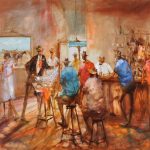How Thunderbolt Robbed the Warialda Mail, April 1865 – SOLD
Detail photos for this Artwork
Research Notes about this painting:
During Hugh Sawrey’s life he captured in his art many tales from the bush and from Australian history, including works that featured bushrangers. In this painting, he features, with detail and some artistic license, the famous bushranger Captain Thunderbolt (c. 1835-1870) sticking up the Warialda Mail in the entertaining oil, “How Thunderbolt Robbed the Warialda Mail, April 1865”.
On 25 April, 1865, “The Maitland Mercury and Hunter River General Advertiser” recorded a story that recounted the event of the Warialda Mail being stuck up by Captain Thunderbolt and his gang on 19 April 1865 near Manilla as the mailman travelled along his route between Tamworth and Warialda. The town of Manilla rests at the junctions of the Namoi and Manilla Rivers, about 45 kilometres north west of Tamworth and 151 kilometres south of Warialda.
For your interest and entertainment, the full newspaper story, obtained from archives at the National Library of Australia, is recorded below towards the end of this article. But first I’ll share a little of the life of Captain Thunderbolt!
Frederick Wordsworth Ward or Captain Thunderbolt as he was to become known, was renowned for being the longest-roaming bushranger in Australia’s history. He became known as the “gentleman bushranger” having never shot or killed anyone during his bushranging career, instead relying on his excellent horse riding skills and superior horses to make a swift getaway and to evade capture. Ward is credited with having stolen or commandeered over 40 thoroughbred racehorses whilst bushranging.
Frederick Ward was the son of a convict Michael Ward and his wife Sophia. Michael Ward sailed to Australia on the “Indefatigable” in 1815. Frederick Ward (Captain Thunderbolt) was born in Windsor in the Hawkesbury area, north west of Sydney in about 1835, as the youngest of ten children.
From the time he was 11 years old Ward was employed working on many stations in regional and northern NSW, including the famed horse-stud “Tocal Run” on the lower Paterson River. He became an expert horseman, horse breaker and drover. These skills and his endurance meant he could survive in the bush for long stretches of time.
In 1856, Frederick Ward’s nephew John Garbutt became the ringleader of a large horse and cattle stealing operation, and enticed other members of the Ward family to join him, including Frederick. The gang drove about 50 stolen horses from the Lambs Valley property of his brother William to Windsor where they were sold at auction. Ward and his nephews were caught and convicted, each receiving a sentence of ten years with hard labour and sent to the Cockatoo Island penal establishment on Sydney Harbour.
Released on tickets of leave (parole) after serving four years, Ward and his nephews settled near Mudgee. John Garbutt married a wealthy widow, Elizabeth Blackman, owner of the Cooyal Inn and station and they employed Fred. In 1860, at Cooyal, Fred met Mary Ann Bugg, a Worimi woman, the daughter of an indigenous mother and convict father. They married soon after in 1861 and Mary Ann fell pregnant with Fred’s child.
Trouble began again for Fred, when in 1861 then just a newlywed, breached his ticket of leave regulations by leaving the Mudgee district to take Mary Ann to her father’s farm at Monkerai near Dungog for their first baby’s delivery. He returned late back to Mudgee for his three-monthly muster and, consequently, was arrested for revoking parole conditions and was sent back to Cockatoo Island.
On 11 September 1863 Ward and an inmate companion Frederick Britten, escaped from a work gang on Cockatoo Island and swam to the mainland, then headed north of Sydney toward New England and Maitland, embarking on a robbing spree.
After his escape from Cockatoo Island, Ward and Mary Ann were reunited. Mary Ann was a skilled and important confidante and accomplice for Ward. She could read and write and was very skilled with bush craft. She helped Ward stay alive, nursed him when injured, and helped him stay ahead of the law. She was his spy, heading into town to inquire about troop movements and coach routes. She warned him off when the troopers came, killed their food and collected their bush tucker, and also bore him three children.
In late October 1863, Ward and Britten were waiting to ambush the mail coach near Split Rock, (now known as Thunderbolt’s Rock), which is located about 6 kilometres south of Uralla. This cluster of large granite boulders offered the bushrangers a perfect vantage point for monitoring the approach of unwary mail coaches. Unfortunately for Ward and Britten, they were spotted by troopers and in the ensuing gunfight, Ward was shot in the back of his left knee but managed to escape. Britten and Ward separated a few weeks later.
Soon after, Ward gained his nickname “Captain Thunderbolt” during a toll-bar house robbery at Rutherford on 21 December 1863 when the toll-bar customs officer, was startled from his sleep by Ward banging loudly and bursting through the door. The shocked officer remarked to police: “By God, I thought it must have been a thunderbolt”. The “Maitland Mercury” newspaper reported this story and the name stuck.
From 1864 to the year of his death in 1870, Ward robbed mailmen, travellers, inns, stores and stations across much of northern NSW – from the Hunter Valley north to Queensland and from Tamworth nearly as far west as Bourke. Ward sometimes included his wide Mary Ann and their children in his crimes. A spree in Dungog, Stroud and Singleton from November 1863 to January 1864 involved the entire bushranging family. In early 1865, the year that is featured in Hugh Sawrey’s painting, Ward and three other accomplices went on crime sprees in the north western plains, including the robbery of the Warialda Mail in 1865.
Ward’s relationship with his wife, Mary Ann Bugg ended late in 1867. In the decades afterwards, Mary Ann gave birth to at least five more children, became a nurse, and married another man. Mary Ann died at the age of 70 in Mudgee on April 22, 1905.
After 1868 Ward, then operating alone, remained largely in seclusion, surfacing only a handful of times in the next 18 months to commit robberies.
In May 1870, Thunderbolt spent his last few hours drinking in and about the Royal Oak Inn, close by Split Rock, at Church Gully. On 25 May 1870, after allegedly robbing travellers near the rock, Ward was eventually shot after a difficult pursuit through rough terrain. He was killed by Constable Alexander Walker after Walker shot Thunderbolt’s horse out from under him in swamp land at Kentucky Creek near Uralla.
Before his burial at the Uralla Cemetery, hundreds flocked to see Thunderbolt’s body and for a shilling, you could buy a postcard of his bullet-ridden body. Constable Walker, along with several others, was eventually awarded a silver medal for bravery.
Thunderbolt’s legacy has been immortalised in several movies, paintings and at an exhibit at McCrossin’s Mill Museum in Uralla. The road that extends from Gloucester to Inverell is known as “Thunderbolts Way” and follows much of his original route between the Hunter Valley and the North West slopes and plains. “Thunderbolt’s Trail” is a 4WD trail located in the Barrington Tops State Forest which also follows part of his original route.
To follow is a newspaper extract from page two of the “The Maitland Mercury and Hunter River General Advertiser” published on Tuesday 25 April, 1865 (about 5 years before Thunderbolt’s death) that recounts his robbery and horse theft of the Warialda Mail on 19 April 1865 near Manilla in the New England area of NSW. Manilla is about 45 kilometres north west of Tamworth and 151 kilometres south of Warialda.
“STICKING-UP OF THE WARIALDA MAIL”
(From the Tamworth Examiner, April 22 1865)
A good deal of excitement was created in Tamworth on Wednesday afternoon last, when it became generally known that the pack-horse mail from Warialda and intermediate townships for Tamworth, had been stuck up and robbed that morning by three armed men.
The following are the particulars, as far as we have been able to learn them, and they may be relied upon:
Between ten and eleven o’clock on the morning of the day previously mentioned, when about four miles from the township of Manilla, Martin Hurley, the mailman, was suddenly called upon by a man who was in company with two others, and who rode down from a ridge on the road, to bail up.
Thinking at first it was a practical joke of some of the stockmen in the neighbourhood, he eased his pace to see what was the matter, but on perceiving that they were all armed with revolvers, he stopped, and one of them, a tall man, about five feet ten inches high, sandy complexion, and light hair, mounted on a fine bay horse, was told by one of the others to remain with the mailman while the other two proceeded a short distance back on the road, where they found Mr Ross, of Myall Creek, driving a buggy in which were Mrs Redhead and family. On riding up to the buggy, one of them, a dark man, with dark bushy hair, inclined to curl, and who seemed to be the captain, said to Mr. Ross, “I must trouble you to bail up, sir,” without, however, presenting any firearms. The buggy was stopped, and Mr Ross observed that both men were armed with three revolvers, one in hand and the others in their belt.
Mr Ross having requested that they would not frighten Mrs Redhead, the same fellow replied that he never molested a lady, nor would he allow anyone with him to do so, and was singularly polite and civil. He then enquired if Mr. Ross had any money with him. When that gentleman replied that he had not, and never carried any on the road, to which the same robber observed that gentlemen never did so now, and he was sorry for it. They did not search Mr Ross or the buggy, but ordered him in a civil manner to draw off the road until they had searched the mail.
Both then left and went to where Hurley was standing, the man who was left in charge of him, having taken him off the road into a little gully. The captain, or dark featured man then ordered the two others to get off their horses and take the mail off the pack horses, which they did, but he did not himself dismount during the whole of the time. They opened the bags and all the letters, without, however, wilfully destroying any of them.
As the contents were exposed, everything in the shape of notes, cheques and orders were handed by the other two to the captain, and he placed them in his breast. They took even half notes and half cheques, and when Hurley remarked that they would be of no use to them, the captain observed that they would get the other halves next time. In the mail was a small parcel of gold, about eight or nine ounces, and this likewise fell into their hands. They took from the mailman his waistcoat, in which was a valuable gold watch, but after keeping it for a little while both were returned to him. Mr Ross had also two gold watches, but, as we have said, they did not search him, or take the watches, notwithstanding that Mr Ross told them that he had the watches on him.
On completing their search, which occupied about half an hour, they told Hurley that they must take his horse, as a mate of theirs, who they said was a short distance off in the bush, wanted it, his own being knocked up.
They took the saddle off, and, laying it down, led the horse away, all leaving together, and taking the direction of the Manilla [River]. As they passed Mr Ross, the captain said that he had not taken any of the letters.
The third person engaged was a youth of about 17 or l8 years of age, fair hair, no beard, about five feet 8 or 9 inches high, very stupid looking, and did precisely as he was ordered by the captain. He rode a fine bay cob, and was armed with revolvers. None of them were in the least disguised, so they can be easily identified, and seemed to be old hands at mail robbing. They did not present their arms during the whole of the time at any of the parties, nor use any violence, but on the contrary are described as having been very polite and civil. The fourth man was not seen. From the description of the men there is very little doubt that these fellows are the well-known Captain Thunderbolt and his gang. This ruffian was known to have been on the Namoi, and to be in company with a boy answering to the description given above.

